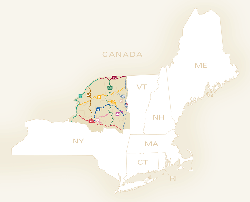The Adirondack North Country Region
The Adirondack North Country region comprises 14 counties west of Lake Champlain and east of Lake Ontario that stretch north from the Mohawk River to the Saint Lawrence River and the Canadian border. The region’s history is as rich and diverse as its landscape is unique and varied. The lakes, ponds, rivers and mountains of the six-million acre Adirondack Park in the center of the region offer myriad recreation and wilderness opportunities.
At the center of the region is New York State’s Adirondack Park, 9,375 square miles within a boundary created by the state legislature in 1892, is a unique blend of public and private lands comprising the largest state park in the lower 48 states. The six-million-acre park has just over three million acres in private ownership and one million acres of the Park’s public land are designated as wilderness. The Adirondack Park is home to 135,000 residents in 105 towns and villages and the summer population soars with seasonal residents and visitors. There is a long tradition of craftsmanship, resourcefulness, and hospitality as well as rugged beauty and rustic charm.
The Adirondack Park is different that any other designated park land in the U.S. and possibly in the world. How it differs from what one might expect in state or federal parks is sometimes surprising to first-time visitors. For example:
- There is no fee to enter the Adirondack Park and there are no gates at the entrances to the Adirondack Park. The boundary of the park is outlined on a map but the only demarcation on the ground are wooden roadside signs at various locations.
- Not all land within the Adirondack Park is public land. The Adirondack Park is a patchwork of public and private land, so signs that announce “No Trespassing” or “Private” should always be obeyed. Most communities have a visitor information center, bike shop or other sporting goods store where maps and information are available that clearly identify the region’s abundant public access opportunities.
- There are no visitor centers at the entrances to the Adirondack Park. There are two Interpretive Centers – one in Newcomb operated by the State University of New York College of Environmental Science & Forestry (SUNY-ESF) and one in Paul Smiths operated by Paul Smiths College – where information about the Adirondack Park is provided, along with trail systems, interpretive displays, guidebooks, and friendly information.
Other major destination areas in the region include the Lake Ontario shore, the Tug Hill Plateau, Thousand Islands, St. Lawrence River, Lake Champlain, Hudson River and the Mohawk River Valley.
For information on planning your next visit to the area, contact one or more of the many tourism information resources listed under our Visitor Info page.





